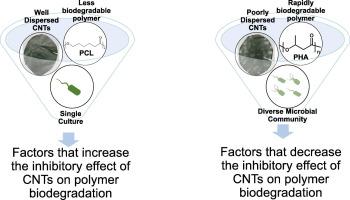Science of the Total Environment ( IF 8.2 ) Pub Date : 2020-06-30 , DOI: 10.1016/j.scitotenv.2020.140512 Benjamin P Frank 1 , David G Goodwin 1 , Pavlo Bohutskyi 2 , Duc C Phan 3 , Xier Lu 4 , Leo Kuwama 4 , Edward J Bouwer 4 , D Howard Fairbrother 1

|
The interaction of anaerobic microorganisms with carbon nanotube/polymer nanocomposites (CNT/PNC) will play a major role in determining their persistence and environmental fate at the end of consumer use when these nano-enabled materials enter landfills and encounter wastewater. Motivated by the need to understand how different parameters (i.e., polymer type, microbial phenotype, CNT characteristics) influence CNT/PNC biodegradation rates, we have used volumetric biogas measurements and kinetic modeling to study biodegradation as a function of polymer type and CNT properties. In one set of experiments, oxidized multiwall carbon nanotubes (O-MWCNTs) with a range of CNT loadings 0–5% w/w were incorporated into poly-ε-caprolactone (PCL) and polyhydroxyalkanoates (PHA) matrices and subjected to biodegradation by an anaerobic microbial community. For each CNT/PNC, complete polymer biodegradation was ultimately observed, although the rate of biodegradation was inhibited above certain critical CNT loadings dependent upon the polymer type. Higher loadings of pristine MWCNTs were needed to decrease the rate of polymer biodegradation compared to O-MWCNTs, an effect ascribed principally to differences in CNT dispersion within the polymer matrices. Above certain CNT loadings, a CNT mat of similar shape to the initial PNC was formed after polymer biodegradation, while below this threshold, CNT aggregates fragmented in the media. In situations where biodegradation was rapid, methanogen growth was disproportionately inhibited compared to the overall microbial community. Analysis of the results obtained from this study indicates that the inhibitory effect of CNTs on polymer biodegradation rate is greatest under conditions (i.e., polymer type, microbial phenotype, CNT dispersion) where biodegradation of the neat polymer is slowest. This new insight provides a means to predict the environmental fate, persistence, and transformations of CNT-enabled polymer materials.
中文翻译:

聚合物类型和碳纳米管性能对碳纳米管/聚合物纳米复合材料生物降解的影响。
当这些具有纳米功能的材料进入垃圾填埋场并遇到废水时,厌氧微生物与碳纳米管/聚合物纳米复合材料(CNT / PNC)的相互作用将在决定其持久性和环境命运方面发挥重要作用。由于需要了解不同参数的启发(我。ê,聚合物类型,微生物表型,CNT特性)影响CNT / PNC的生物降解率,我们使用了沼气的体积测量和动力学模型来研究生物降解与聚合物类型和CNT特性的关系。在一组实验中,将一系列CNT负载量为0–5%w / w的氧化多壁碳纳米管(O-MWCNT)掺入聚ε-己内酯(PCL)和聚羟基链烷酸酯(PHA)基质中,并通过以下方法进行生物降解:厌氧微生物群落。对于每种CNT / PNC,最终观察到了完全的聚合物生物降解,尽管在取决于聚合物类型的某些临界CNT负载之上生物降解的速率受到抑制。与O-MWCNT相比,需要更高的原始MWCNT负载量以降低聚合物的生物降解速率,这种作用主要归因于聚合物基质中CNT分散度的差异。在某些CNT负载以上时,聚合物生物降解后会形成形状类似于初始PNC的CNT垫,而在此阈值以下时,CNT聚集体会在介质中破碎。在生物降解迅速的情况下,与整个微生物群落相比,甲烷菌的生长受到不成比例的抑制。从这项研究获得的结果的分析表明,在以下条件下,CNTs对聚合物生物降解速率的抑制作用最大:与整个微生物群落相比,甲烷菌的生长受到不成比例的抑制。从这项研究获得的结果的分析表明,在以下条件下,CNTs对聚合物生物降解速率的抑制作用最大:与整个微生物群落相比,甲烷菌的生长受到不成比例的抑制。从这项研究获得的结果的分析表明,在以下条件下,CNTs对聚合物生物降解速率的抑制作用最大:我。(例如,聚合物类型,微生物表型,CNT分散体),其中纯净聚合物的生物降解最慢。这一新见解提供了一种手段,可预测启用CNT的聚合物材料的环境命运,持久性和转变。











































 京公网安备 11010802027423号
京公网安备 11010802027423号